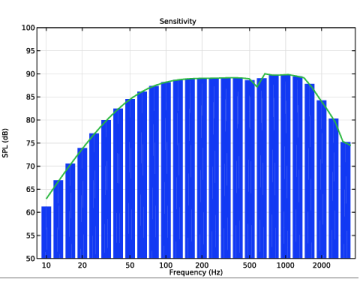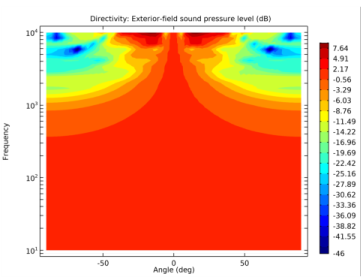The 3D radiation pattern plots create a 3D polar plot (or bubble plot) where the data is evaluated on a sphere. Here, you can specify a separate expression for the surface color. In the 3D radiation pattern plots, the directivity can also be calculated by enabling the Compute directivity option. The result is given in a table and is calculated as the maximum power relative to the average power. The table comprises the maximal radiation direction (polar angles), the directivity, and the directivity given in dB (also known as the directivity index).
Variables defined by the Exterior Field Calculation feature like, for example, the pressure
acpr.efc1.pext or sound pressure level acpr.efc1.Lp_pext are globally defined variables and can be directly evaluated in the
Radiation Pattern plot and
Directivity plot. The values plotted only make physical sense if they are evaluated outside of the
Exterior Field Calculation boundary.
To visualize, for example, the sound pressure level inside of the Exterior Field Calculation boundary plot the expression:
at2(x,y,acpr.Lp) in 2D,
at2(r,z,acpr.Lp) in 2D axisymmetry, or
at3(x,y,z,acpr.Lp) in 3D. The
at2() and
at3() operators ensure the variables are globally defined.
Another way of evaluating and depicting the exterior field is by using either the Grid 2D, the
Grid 3D, the
Parametrized Curve, or the
Parametrized Surface data sets. Both types of data sets allow the evaluation of global quantities, like the exterior field variables, outside of the computational domain (outside of the mesh).
A dedicated Octave Band (

) plot exists to plot frequency response, transfer functions, transmission loss, and insertion loss curves. The plot has several built-in acoustics specific features like predefined weighting (Z, A, C, and User defined) as well as the possibility to plot the response in octaves, 1/3 octaves, 1/6 octaves, or as a continuous response.

Another acoustics specific plot, especially used for loudspeakers, is the dedicated Directivity (

) plot. The plot allows audio engineers to depict the spatial response of a loudspeaker as function of both frequency and spatial angle in a contour-like plot. Representing the spatial response in this manner is a very common in the loudspeaker industry. Measured data is often also represented in the same manner. The plot includes many options to format the plot to achieve maximal insight into the modeled data, for example, linear and logarithmic frequency axis scaling options, easy switch of the x- and y-axis (frequency and polar angle axis), as well as options to normalize the data with respect to a given angle or the maximal value.




